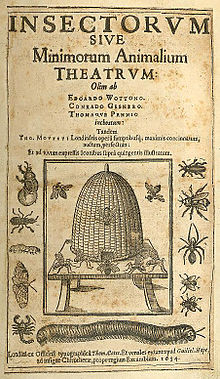Thomas Muffet
Thomas Muffet (* 1553 in Shoreditch , London ; † June 5, 1604 in Bulbridge, Wilton , Wiltshire ), also Moffett or Moufet , was an English doctor and naturalist who was best known for his studies on insects.
Life
Muffet was the son of a dealer in buttons and other utensils for clothing (Haberdasher). He went to the Merchant Taylor School in London. Between 1569 and 1573 Muffet attended Trinity College and Gonville Hall in Cambridge. After studying medicine with Thomas Lorkin and John Caius , he obtained his doctorate in Basel in 1578. He then visited Italy and Spain. In 1580 Muffet studied the anatomy of the silkworm in Italy. In 1580 he married Jane Wheeler and traveled to Germany and Denmark, where he met Severinus. In 1582 he was back in Cambridge and settled as a doctor in Ipswich and later in London. In 1584 he published the work De iure et praestantia chemicorum medicamentorum dialogus apologeticus in Frankfurt , which was widely read on the continent and shows him as a follower of Paracelsus (it was reprinted in the Theatrum Chemicum ). In 1588 he published Nosomantica Hippocratea and became a Fellow of the College of Physicians. After the death of his wife in 1600, he married Catherine Brown, with whom he had a daughter. He was the doctor of high aristocrats and so came to the court of Queen Elizabeth I. At the influence of the Duke of Pembroke, he moved to Wiltshire and in 1597 received a seat in Parliament for Wilton, which he had until 1604.
Muffet was considered a supporter of Paracelsus , whose medical teaching was controversial in medical-scientific circles at the time and Muffet got to know on the continent.
plant
Muffet wrote the work Insectorum sive Minimorum Animalium Theatrum in which he used unpublished material from Gessner , Wotton and Penny . Gesner's unfinished work was bought by his friend Penny, who added his own observations and Wotton's notes, which he also acquired. After Penny's death, Muffet acquired the manuscript from the heirs and added material (descriptions, drawings) on insects, spiders, worms and crustaceans himself. However, it wasn't published until thirty years after Muffet's death. During his lifetime, Muffet tried in vain to find a printer in The Hague and London. After his death it came to Muffet's pharmacist, who sold it to Theodore Mayerne , who published it in Latin in 1634 with cheap woodcuts. An English edition (The Theater of Insects; or, lesser Living Creatures: as Bees, Flies, Caterpillars, to Spiders, Worms & c.) Appeared in 1658 as the third volume of History of four-footed beasts and serpents by Edward Topsell . His book Health's Improvement (published by Christopher Bennet after his death in 1655) is aimed at laypeople and is primarily concerned with nutrition, including wild birds. It contains the UK's first printed list of wild birds and early bird migration observations (among the first, after Diana Simpkins). He also wrote treatises on healing arts and a poem on silkworms (under the abbreviation TM).
Book I of the Theater of Insects includes winged insects, beetles, and bees; Book II the "wingless insects" such as caterpillars, worms, spiders and others. With this, Muffet follows the classification of Aristotle , who distinguished insects into wingless and winged ones. He treated butterflies and their caterpillars separately and found that there are as many caterpillar species as there are butterfly species. He found that the same caterpillars, in addition to the respective butterflies, also hatch parasitic wasps (which he describes as common flies). He described the devastation caused by locusts in Europe and their use as food. Muffet also described the mechanism of the chameleon's tongue in catching insects.
His manuscript on insects (Theatrum insectorum) has an engraving by the authors Wotton, Penny, Gesner, Muffet as the title page and is in the British Museum (Sloane MS 4014).
Web links
literature
- Sidney Lee , Article Muffet in Dictionary of National Biography , wikisource
- Natalie Zemon Davis : Metamorphoses. The life of Maria Sibylla Merian. Berlin 2003, pp. 22, 32, 35, 138.
- Diana M. Simpkins: Moffett (Moufet, Muffet), Thomas , in: Charles C. Gillispie, Ed .: Dictionary of Scientific Biography . New York 1974.
- CE Raven : English Naturalists from Neckham to Ray, Cambridge, 1947
- WH Mullens: Thomas Muffett, Hastings and St. Leonards Natural History Society, Occasional Publication no.5, 1911
- M. Burr: Unpublished for Over Three Hundred Years: the Original Title-Page for the First Book on Natural History Printed in England, in: Field, August 27, 1938, p. 495
- HM Fraser: Moufet's Theatrum Insectorum, in: Gesnerus , Volume 3, 1946, p. 131 (and B. Milt: Some Explanatory Notes to Mr. HM Fraser's Article about Moufet's Theatrum Insectorum, Gesnerus, Volume 3, 1946, p. 132– 134)
References and comments
- ^ Facsimile edition by Willy Ley, London 1967
- ^ Second edition in 1746 with a biography of Muffet by W. Oldys
- ^ Dictionary of Scientific Biography
| personal data | |
|---|---|
| SURNAME | Muffet, Thomas |
| ALTERNATIVE NAMES | Moffet, Thomas; Mouffet, Thomas |
| BRIEF DESCRIPTION | English doctor and naturalist |
| DATE OF BIRTH | 1553 |
| PLACE OF BIRTH | Shoreditch , London |
| DATE OF DEATH | June 5, 1604 |
| Place of death | Wilton, Wiltshire |
